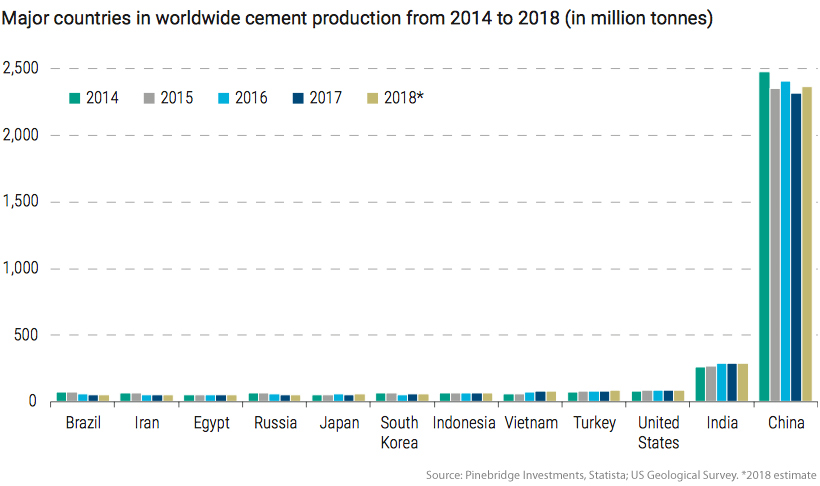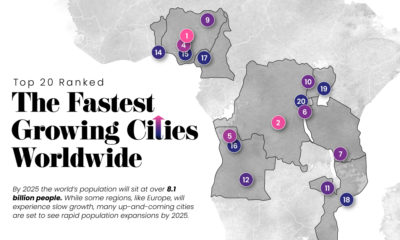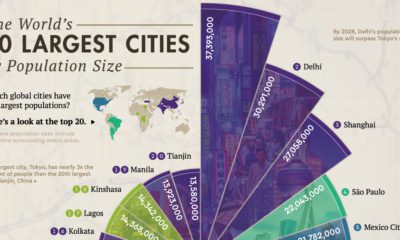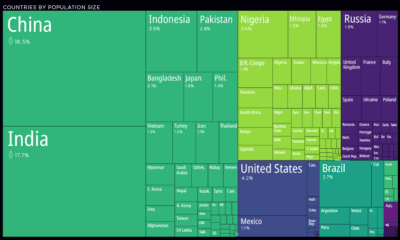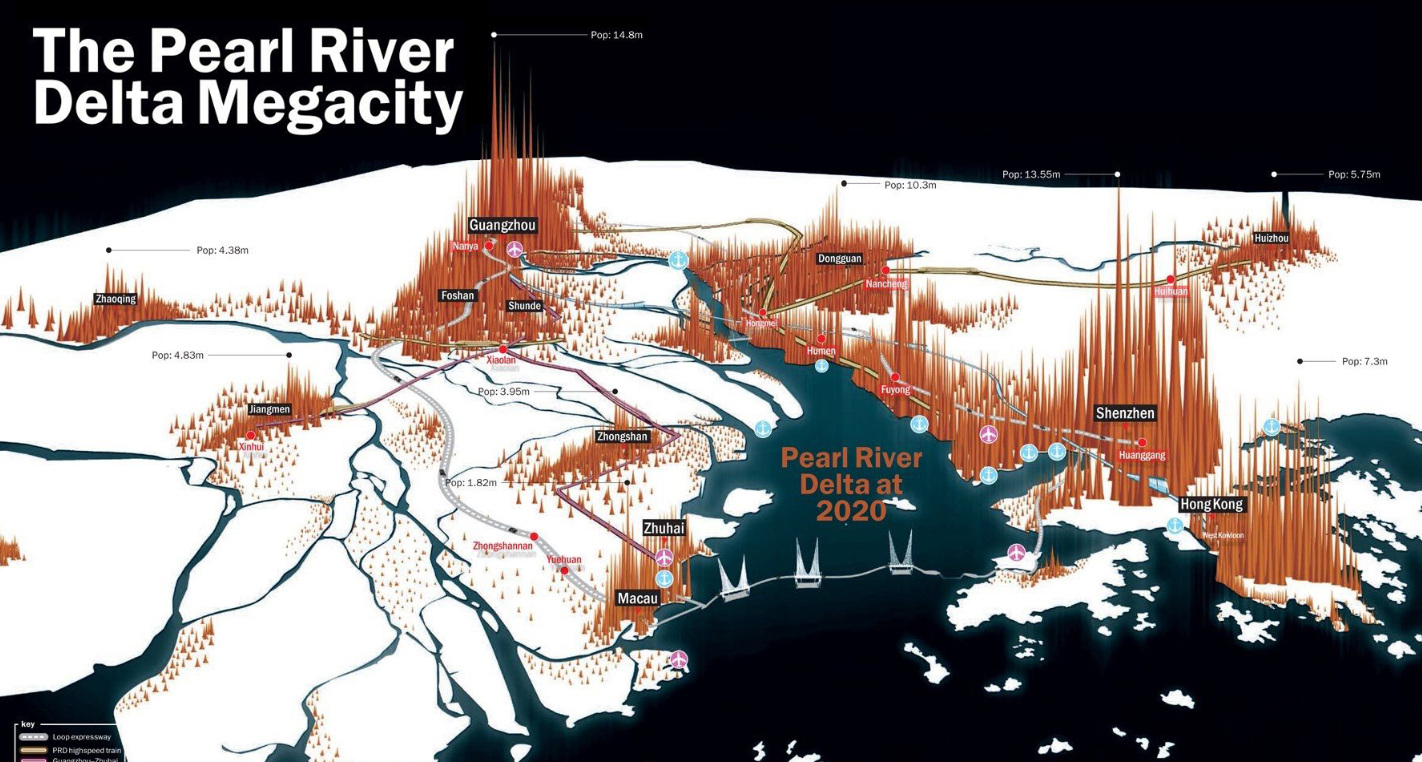Just three decades prior, China looked markedly different. Only 20% of Chinese citizens lived in urban areas, and many of today’s metropolises were still small villages. Since then, huge swaths of the population have moved from farmland into cities, a shift that is still causing many urban areas to swell in size. Case in point is the growth of Guangzhou, which lays just north of Hong Kong. From 1980 to today, more than 18 million people moved into the city. A 40-year-old born in Guangzhou will have seen their small, regional city mushroom into one of the largest urban amalgamations on Earth. Of course, this is just one example of a process that has been altering the landscape of cities from the coast of the South China Sea out to the Eurasian Steppe.
The One Million+ Club
According to Demographia’s World Urban Areas report, there are now 113 urban areas in China that surpass the one million population threshold. In comparison, North America and the EU combined have 114 urban areas that surpass one million people. Below is a full breakdown of China’s one million+ club:
Unparalleled Urbanization
The massive scale of rural-to-urban migration isn’t just a major development within China, it has no parallel in modern history. Since 1980, over half a billion people have moved from the countryside to an urban center. The construction of these new cities took a staggering amount of raw materials. Few data points highlight the scale of construction better than China’s cement production in recent years.
In 2018, Chinese construction used about 8x the amount of second place India, which has a similar population size.
Megacities on Megacities
Cities with over 10 million inhabitants are defined as megacities. China is already home to six megacities, with another three urban areas well on the way to achieving that status. In fact, some megacities within close proximity have grown so large that they are merging into contiguous urban areas. The most prominent example of this phenomenon is in the Pearl River Delta region of China. The Pearl River Delta region is not only home to the megacities of Guangzhou and Shenzhen, but also a number of other sizable cities that are quickly merging into a unified continuous entity containing up to 50 million people. Demographia still considers most of these cities to be separate labor markets — but as more connections form across the region, the Pearl River Delta could be poised to become the largest unified urban area in human history.
Westward Migration
As megacities like Shanghai and Shenzhen have grown and developed, they’ve also become more expensive places to live and do business. The economic evolution of these cities has created opportunity for smaller, less developed cities to woo both residents and businesses. This natural reshuffling has led to impressive growth in cities further inland like Zhengzhou, which sits 350 miles (630 kms) east of the coastline where many of the country’s largest cities reside. Using the “build it and they will come” approach, the city converted a 160 square mile (410 sq km) patch of empty land into the Zhengzhou Airport Economy Zone (ZAEZ). The project has proven wildly successful, and the city even has the nickname “Apple City” thanks to the presence of Foxconn (which produces the iPhone) and a cluster of other smartphone manufacturers.
This airport-centered zone was developed with the full political and economic backing of Beijing as part of a broader effort to increase economic activity in China’s interior cities. Zhengzhou has nearly tripled in size over the last decade, a powerful testament to the shift in economic momentum. China’s Inland All-Stars: Compare the numbers above to fast-growing cities in the U.S., such as Las Vegas or Phoenix, which managed 33% and 12% growth respectively over the last decade. If this trend continues, China’s one million+ club will most likely expand once fresh census data is released in 2021. on Even while political regimes across these countries have changed over time, they’ve largely followed a few different types of governance. Today, every country can ultimately be classified into just nine broad forms of government systems. This map by Truman Du uses information from Wikipedia to map the government systems that rule the world today.
Countries By Type of Government
It’s important to note that this map charts government systems according to each country’s legal framework. Many countries have constitutions stating their de jure or legally recognized system of government, but their de facto or realized form of governance may be quite different. Here is a list of the stated government system of UN member states and observers as of January 2023: Let’s take a closer look at some of these systems.
Monarchies
Brought back into the spotlight after the death of Queen Elizabeth II of England in September 2022, this form of government has a single ruler. They carry titles from king and queen to sultan or emperor, and their government systems can be further divided into three modern types: constitutional, semi-constitutional, and absolute. A constitutional monarchy sees the monarch act as head of state within the parameters of a constitution, giving them little to no real power. For example, King Charles III is the head of 15 Commonwealth nations including Canada and Australia. However, each has their own head of government. On the other hand, a semi-constitutional monarchy lets the monarch or ruling royal family retain substantial political powers, as is the case in Jordan and Morocco. However, their monarchs still rule the country according to a democratic constitution and in concert with other institutions. Finally, an absolute monarchy is most like the monarchies of old, where the ruler has full power over governance, with modern examples including Saudi Arabia and Vatican City.
Republics
Unlike monarchies, the people hold the power in a republic government system, directly electing representatives to form government. Again, there are multiple types of modern republic governments: presidential, semi-presidential, and parliamentary. The presidential republic could be considered a direct progression from monarchies. This system has a strong and independent chief executive with extensive powers when it comes to domestic affairs and foreign policy. An example of this is the United States, where the President is both the head of state and the head of government. In a semi-presidential republic, the president is the head of state and has some executive powers that are independent of the legislature. However, the prime minister (or chancellor or equivalent title) is the head of government, responsible to the legislature along with the cabinet. Russia is a classic example of this type of government. The last type of republic system is parliamentary. In this system, the president is a figurehead, while the head of government holds real power and is validated by and accountable to the parliament. This type of system can be seen in Germany, Italy, and India and is akin to constitutional monarchies. It’s also important to point out that some parliamentary republic systems operate slightly differently. For example in South Africa, the president is both the head of state and government, but is elected directly by the legislature. This leaves them (and their ministries) potentially subject to parliamentary confidence.
One-Party State
Many of the systems above involve multiple political parties vying to rule and govern their respective countries. In a one-party state, also called a single-party state or single-party system, only one political party has the right to form government. All other political parties are either outlawed or only allowed limited participation in elections. In this system, a country’s head of state and head of government can be executive or ceremonial but political power is constitutionally linked to a single political movement. China is the most well-known example of this government system, with the General Secretary of the Communist Party of China ruling as the de facto leader since 1989.
Provisional
The final form of government is a provisional government formed as an interim or transitional government. In this system, an emergency governmental body is created to manage political transitions after the collapse of a government, or when a new state is formed. Often these evolve into fully constitutionalized systems, but sometimes they hold power for longer than expected. Some examples of countries that are considered provisional include Libya, Burkina Faso, and Chad.

